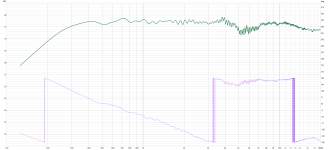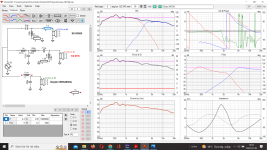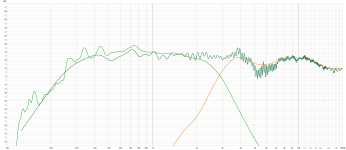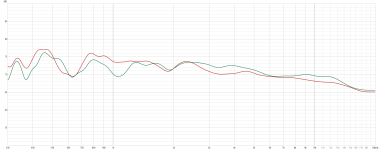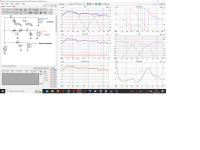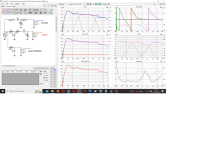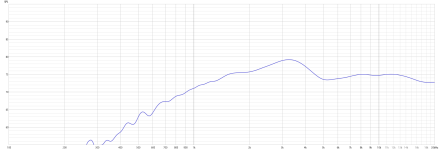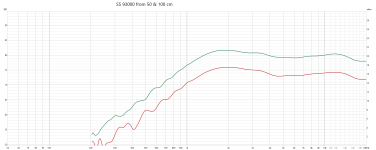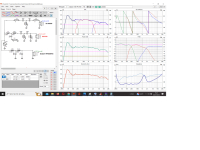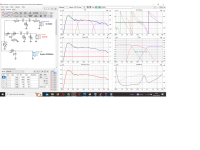Good day.
Just as an aid I would go back to the beginning of the tweeter xover and remove the resistors and remind yourself of the shape of the tweeter response. Does it still have the emphasis?
Adjust the L and C components within sensible limits and see how they interact, the first capacitor could maybe be lowered to help and the second will have a subtle effect also play with the inductor value. Maybe add a series resistor to the inductor leg to help with the tuning.
I guess after a coffee and hours effort you should have a feel for its behaviour. You can add the attenuation back in to make it fit, carefully go over the phase aspects etc. Differing placement of the attenuation elements and checking how they affect impedance could be another coffee and some further time.
If it doesn't want to play ball ?
You could try a second order and vary the turnover and see what it does in terms of the overall response, a small trough should ruin the overall design.
Put an resistor in parallel with the first capacitor to give you a shelving effect, this could possible work and then add attenuation where needed to pull it down in amplitude and match it with the rest of the design.
I think in every case its better nobody mentions first order, simply because you like to listen loud ? 🙂
Just as an aid I would go back to the beginning of the tweeter xover and remove the resistors and remind yourself of the shape of the tweeter response. Does it still have the emphasis?
Adjust the L and C components within sensible limits and see how they interact, the first capacitor could maybe be lowered to help and the second will have a subtle effect also play with the inductor value. Maybe add a series resistor to the inductor leg to help with the tuning.
I guess after a coffee and hours effort you should have a feel for its behaviour. You can add the attenuation back in to make it fit, carefully go over the phase aspects etc. Differing placement of the attenuation elements and checking how they affect impedance could be another coffee and some further time.
If it doesn't want to play ball ?
You could try a second order and vary the turnover and see what it does in terms of the overall response, a small trough should ruin the overall design.
Put an resistor in parallel with the first capacitor to give you a shelving effect, this could possible work and then add attenuation where needed to pull it down in amplitude and match it with the rest of the design.
I think in every case its better nobody mentions first order, simply because you like to listen loud ? 🙂
Last edited:
Hallo Ray hope your weekend was fine 🙂Good day.
Just as an aid I would go back to the beginning of the tweeter xover
I almost did what you said, but shiffted coffee to beer 👍
After many hours trying, i get it to be "flatter"....But still not down to 2,4K ( and more beer, at the end i fellt happy anyway hahaha)
At 2,8K i "dropps ca 1-2 dB around 5K, but still testing different things. ( 4 dB dipp at 4 K....hate it)
It look´s like this now without smoothing, and no woofer. ( I will reduce the twe a few dB at the end later)
The phase looks "strange" or?
Best regards John
Attachments
Measure obove have this filter.
And as you see "in real life" the tweeter don´t dropp like the simulation shows, and no "knee" either.
Here is also measurements on midrange alone, tweeter alone!
And as you see "in real life" the tweeter don´t dropp like the simulation shows, and no "knee" either.
Here is also measurements on midrange alone, tweeter alone!
Attachments
Last edited:
Hi Jawen,
A hot day here so beer needed to get through it.
VituixCad data looks reasonable, but post 163 suggests more work on phase is needed.
Then back to VituixCad phase between mid and tweeter is nice and close?
Have a listen and move around within the listening area to check for the characteristics you want from them.
A hot day here so beer needed to get through it.
VituixCad data looks reasonable, but post 163 suggests more work on phase is needed.
Then back to VituixCad phase between mid and tweeter is nice and close?
Have a listen and move around within the listening area to check for the characteristics you want from them.
Work some on the 3 way, and tested 2 different xover´s.
The SS 9300 dipp at 4-5K seems to be worse when measurement from 50-150 cm, it flatens out at 2 m.
This is from 2,9 m and where my head is in the sofa, Red is Left xover and Green is Right xover.
Is any of them "better" than the other?
Phasewise?
Regards John
The SS 9300 dipp at 4-5K seems to be worse when measurement from 50-150 cm, it flatens out at 2 m.
This is from 2,9 m and where my head is in the sofa, Red is Left xover and Green is Right xover.
Is any of them "better" than the other?
Phasewise?
Regards John
Attachments
I Like the right one for its better phase alignment.
Also the impedance and electrical phase angle behaviour is slightly better in my opinion.
I don't know if this data could be input into Shadow play62's simulation maybe he could drive VituixCad to show how it behaves over differing angles?
A question about the tweeter crossover, it models with a little bump at 4-5KHz but the measured data doesnt show it. I wonder how it measures and sounds as you reduce the capacitor by one or two values. This is something i would take a day over measuring and listening just to see what I like the best. As long s values and other things are sensible the ear has the casting vote.
I hope you are feeling a bit better, and enjoy the day.
Also the impedance and electrical phase angle behaviour is slightly better in my opinion.
I don't know if this data could be input into Shadow play62's simulation maybe he could drive VituixCad to show how it behaves over differing angles?
A question about the tweeter crossover, it models with a little bump at 4-5KHz but the measured data doesnt show it. I wonder how it measures and sounds as you reduce the capacitor by one or two values. This is something i would take a day over measuring and listening just to see what I like the best. As long s values and other things are sensible the ear has the casting vote.
I hope you are feeling a bit better, and enjoy the day.
2 cents worth >
Given a highly asymmetrical listening room, best sound-stage can sometimes require deliberate/intentional crossovers
that are different for Right ch. and Left ch. Asymmetrical room 'functions' actually exhibit different L/R phase response.
Given a highly asymmetrical listening room, best sound-stage can sometimes require deliberate/intentional crossovers
that are different for Right ch. and Left ch. Asymmetrical room 'functions' actually exhibit different L/R phase response.
Hi Ray 🙂A question about the tweeter crossover, it models with a little bump at 4-5KHz but the measured data doesnt show it
This SS 9300 has made me frustrated many times now. ( and my extra xover-parts are gone, so have to borrow from other projects)
So in the end i did a new measurement in the room without xover, mic at 1 m. (speaker at 1,5 m in high)
And this is what it look like!
It dropps 5,5 dB from 3,5K to 5K
So last week I work with that "new" tweeter SPL curve in these 2 last xover´s.
Seems "more difficult than usual" to measure the SS 9300 tweeter, & some measurements show about 2 dB dip & some show larger variations
As you see at the outside measurement from 50 and 100 cm, the dipp is at exaktly the same "spot", but only 2 dB outside.
I wonder how it measures and sounds as you reduce the capacitor by one or two values.
Had test quite much smaller variation´s, but will try some more today 👍
Think you are 100% right here with my "extreme asymmetrical listening room", but will not complicate things so have to find a form of "middeling"Given a highly asymmetrical listening room, best sound-stage can sometimes require deliberate/intentional crossovers
that are different for Right ch. and Left ch. Asymmetrical room 'functions' actually exhibit different L/R phase response.
Hope you have a great weekend guy´s
Regards John
Attachments
Just to maby learn a little "more".
Here is 2 xover´s with the only diffarance of secund or fourht order at woofer.
If we looka at GD & Phase,is one "better" than the other?
Regards John
I Like the right one for its better phase alignment
Here is 2 xover´s with the only diffarance of secund or fourht order at woofer.
If we looka at GD & Phase,is one "better" than the other?
Regards John
Attachments
In terms of phase tracking the first one is has all the drivers being well aligned for phase. Which is a sensible place to be, and shows that some effort has gone into the design.
Remembering everything to do with loudspeakers is a compromise, you can use it good sanity check of the design.
I.e. it doesn't have to be 100% accurate. therefore being slightly off is not a big problem. If another component change gives a better overall sound yet degrades the phase so be it. Some speakers from the 70s and 80s don't have such good phase match and still sound reasonable.
For group delay I am not sure what is going on there as there are no wiggles in the line which I would expect certainly in the LF I am not sure why that is as you have phase ? Maybe the GD tab is not clicked, wild guess on my part?
Remembering everything to do with loudspeakers is a compromise, you can use it good sanity check of the design.
I.e. it doesn't have to be 100% accurate. therefore being slightly off is not a big problem. If another component change gives a better overall sound yet degrades the phase so be it. Some speakers from the 70s and 80s don't have such good phase match and still sound reasonable.
For group delay I am not sure what is going on there as there are no wiggles in the line which I would expect certainly in the LF I am not sure why that is as you have phase ? Maybe the GD tab is not clicked, wild guess on my part?
Now I click "show normal group delay" in GD & Phase windowFor group delay I am not sure what is going on there as there are no wiggles in the line which I would expect certainly in the LF I am not sure why that is as you have phase ? Maybe the GD tab is not clicked, wild guess on my part?
Attachments
Have to come back on this. What you most likely see is the baffle step function of the tweeter enclosure. It looks pretty similar to every tweeter with a 104mm diameter front plate that is measured in free air.Begain again with measurements, but going ceazy at SS 9300 "knee" at 5K
And have realized that it is not possible to have a resistor before the tweeter, gets the "knee" bigger however I do..
Wonder if the Ferrofluid can be a problem?
- Home
- Loudspeakers
- Multi-Way
- 4-800 Hz wiggle i my 3 way diy
